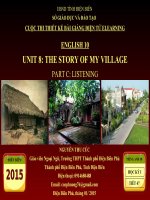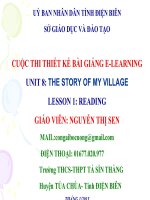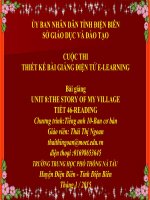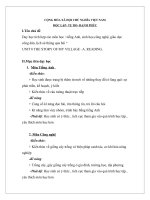Giáo án Tiếng Anh 10 Unit 8: The story of my village
Bạn đang xem bản rút gọn của tài liệu. Xem và tải ngay bản đầy đủ của tài liệu tại đây (147.22 KB, 28 trang )
Giáo án Tiếng Anh 10
Unit Eight : THE STORY OF MY VILLAGE
A: READING
Time: 45 minutes
I. Objectives
1. Educational aim: Students should appreciate the knowledge that they are
learning at school because it can help them make their lives better.
2. Knowledge:
- General knowledge: Students will be able to understand the passage
through matching words and their meanings, answering questions, and
completing a table.
- Language:
New words: words related to village.
3.Skills: Reading for specific information and words’ meanings.
II. Teaching method: Integrate, mainly communicative
III. Teaching aids: Pictures, poster
IV. Procedures:
Teacher’s activities
Students’ activities
* Warm – up : (4mn)
– Ask Sts some questions
1- What do your parents do?
- Sts’ answers may vary
2- Where do they work?
1- They are farmers.
3- What will you do to help them in the
2- They work in the field
future?
– Lead in.
VII.
3- Vary
* Pre-reading : (10mn)
- Ask Sts to look at the picture in their books and
answer the questions.
1.Who are the people in the picture?
2.What are they doing?
3.How are they working?
Sts answer
1.(They are) farmers.
4.Is the crop good?
2.They are working.
5.What helps produce good crops ?
3.They are working hard.
4.Yes, it is.
- T introduces : machines as well as good farming
5.Machines help produce good
methods help farmers make their lives better. So,
crops.
where do they get these methods? The reading
selection in Unit 8 will give you the answer.
* Pre-teach vocabulary
-straw
(n) : Rơm rạ
(realia)
-mud
(n): bùn, xình
(example)
muddy (adj):
- Sts listen, repeat and give
-shortage (n): Sự thiếu thốn
(example)
meaning
-bumper crop (n): vụ mùa bội thu = good crop
- cash crop (n): Trồng cây thương phẩm (transl)
- make ends meet (v.phr) có đủ tiền mua những
thứ cần thiết
(transl)
* Checking vocabulary: Rub out and remember
* While-reading (20mn)
- Ask Sts to read the passage and do task 1
TASK 1: The words in A appear in the reading
passage. Match them with their definitions in B.
- Read the passage
- Give instructions and get Sts to work
individually
- Go around to control the class and offer help.
- Call some Sts to write the answers on the board.
- Ss work individually then
compare the answers with a
partner.
- Remark and conduct the correct answers
- Ss write the answers on the board
and checks whether they understand the words or
not.
Suggested answer:
1.b
2.d
3.a
4.e
5.c
TASK 2: The reading passage tells us about many
changes in the village. Complete the following
table.
- Stick a poster on the board and give instruction.
- Go around and help them.
- Asks one student of each group to write the
answer.
- Give correction
Ss work in groups.
- Ss write the answer in the table.
Suggested answer:
Areas
Before
Now
of
change
houses
made of
made of brick
straw and
mud
radio
few
and TV families
had a radio
many families
have radio or
TASK 3 : Answer the following questions:
or a TV set
(textbook page 84)
farmin
- Give instruction and get Sts to work in pairs
g
old
TV set
new
method
- Go around to help students
- Get some Sts at random to ask and answer aloud
and then write on the b.b
s
crops
poor
travel
good/bumper
by motorbike
- Remark and correct the answers
- Ss read and answer in pairs
- Ask and answer then write down
Suggested answer:
1. It was poor and simple.
2. Because they hoped that with an
education
of
science
and
technology, their children could
find a way of bettering their lives.
3.They introduced new farming
methods which resulted in bumper
crops. They also helped grow cash
crops for export.
4.He said their lives had changed a
lot thanks to the knowledge their
children had brought home.
5.He told his grandchildren” Study
Post-reading (9mn)
harder so that you can do even
Discuss the following question:
more for the village than your
parents did.”
How can people with an education help make the
life of their community better ?
- Explain the question and divide the class into
some groups , then ask them to discuss
- Go around to help Sts
- Ask the secretary of each group to give their
ideas
- Sts discuss in groups
- Write good ideas on the board and give feedback
- Sts give ideas ideas of his/her
group and the others can give more
ideas
Suggested answer
-People with an education help
make the life of their community
better by appying new farming
HOMEWORK :
Write a short paragraph (50 words) about the good
things that people with an education bring to the
community.
Comments : (2mn)
mrthod, growing cask crops for
export
Unit Eight : THE STORY OF MY VILLAGE
B: SPEAKING
Time: 45 minutes
I. Objectives
1. Educational aim: By the end of the lesson, students will be able to talk
about their plans and possible results.
2. Knowledge:
- General knowledge: Through this unit, students learn about how to
make life in the village better.
- Language: sentences and expressions for giving the ideas of improving
the
village.
3.Skills: Fluency in giving the ideas and making suggestions about the
village.
II. Teaching method: Integrate, mainly communicative
III. Teaching aids: Poster
IV. Procedures:
Teacher’s activities
Students’ activities
* Warm-up: (5mn)
- Write the incomplete words on the board,ask sts -look at the words and try to give
to give complete words
complete words in pairs
Answer key :
RO_DS
ROADS
M_DIC_L C_NT_E
MEDICAL CENTRE
CR_PS
CROPS
SCH_OL
SCHOOL
FO_TB_LL GRO_ND
FOOTBALL GROUND
- Lead in
- Teacher says: to make life in the country better,
what should be done with things mentioned
above ?
Task 1 (13mn)
-Explain the requirements in Task1 (The villagers
of Ha Xuyen are discussing plans to improve life in
the village. Match each of the plans with its
possible result)
-Explain new words :
+ to improve
cải tiến, cải tạo
+ to widen
mở rộng
+ to raise
nâng cấp, nâng lên
+ to resurface
trải nhựa
- Get Sts to work in pairs, then compare the result
with their partners
- Get Sts to provide the answers
- Remark and correct together
-work in pairs, then compare the
result with each other
- Sts give the answers on the b.b
Answers :
1.b ,
Task 2 : (15mn)
6.c,
2.g ,
3.d,
7.a
-Explain the requirements in task 2 (p.85)
- Explain and practise pronouncing some new
words : flooded, muddy, cart
Model :
- Call 3 good students to practise the the
conversation
- Get Sts to work in groups of 3
- Practise aloud
- Go around to check and help them
- Get some groups to practise the the conversation
Task 3 : (10mn)
Using the ideas in task 1 ( you may ask some more
- Sts work in groups
4.e,
5. f ,
possible results if you like ) to continue the - Sts work
conversation.
- Give model. (poster)
A: I know what should we do first. We should built
a new school.
B: That’s a great idea. If the new school is built,
children will have better learning conditions.
C: Yes, if the new school is built, we don’t have to
take them to school everyday.
- Get Sts to work in groups of 3 to continue
- Go around the class and help the poor students to
speak out, using the target language.
- Ask some Ss to play the conversation in front of
the class.
- Pay attention to their speaking, take notes of
mistakes, then correct them (mainly the basic
mistakes)
*Homework :
- Write a short paragraph about how to improve
life in your village (30-40 words)
-work in groups of 3 or 4, practise
speaking more freely
Comments : (2mn)
-write the assignment
Unit Eight : THE STORY OF MY VILLAGE
C: LISTENING
Time: 45 minutes
I. Objectives
Educational aim: By the end of the lesson, students will be able to:
-compare the past and the present of a town,
-improve listening skills through true –false and gap-filling
exercise.
II. Teaching method: Integrate, mainly communicative
III. Teaching aids: textbook, cassette player,…
IV. Procedures:
Teacher’s activities
Students’ activities
Warm-Up : (4mn)
-Find someone who (Poster)
- go around the class and interview
-Ask students Yes/no questions : Did you use
to…, and write ss’ name with “yes” answers
their classmates
-write 4 people having the answer
“yes”
Did you use to…?
have a nickname…?
Name
have a pet…?
make wet at night
when you were a
child?
- Nan used to make wet when he was a child,
but now he doesn’t.
- Lead in
Pre-listening: (10mn)
- Get Sts to look at the pictures in th textbooks
-Ask students to look at the pictures and find
the differences in pairs
-work in pairs
-look at the pictures carefully and
-Call some students to share their finding in discuss the differences between them
front of the class
-Suggested answers
+ In the past, there weren’t any hotels,
but now there is a hotel in the town.
+ in the past, the town used to have
only small houses, but now they are
bigger
+ In the past, the animals used to walk
on the roads, but now, there aren’t any
animals on the roads.
+ In the past, there were a lot of trees,
but now there aren’t.
-Explain some new words:
+ hotel(n)
+quiet(a)
+ crowded(a)
+ suburb(n)
While-listening :(18mn)
-read statements
Task 1:
-guess T or F
- Run through the statements the sk them to -listen to the tape twice
guess True or false
-take notes the important information
- Ask students to listen to the tape and decide
-do task 1
whether the statements are true or false
according to the talk.
- Call on some Sts to read their answers aloud in Answers
front of the class, then explain.
-Give feedback and correct answers :
1. F
2. F
3.T
4.F
5.F
- Tell students to read a part of the talk carefully
and have a guess of the missing words.
-Ask students to listen to the tape again and fill
the gaps with the words they hear.
-Ask
students
to
write
the
exact
and
-read the passage
-listen to the talk again and write the
grammatically correct words
-Feedback and give correct answers:
1. house
2.hotel
3.widened
4. cut
5. car
6. shop
missing words
7. department 8. expensive
Post-listening (10mn)
-Ask students to work in pairs : Discuss the
changes in your own
hometown or home
village.
-Ask students to use the present perfect to show
the changes
-Go around the class and help the poor students
if necessary.
*HOMEWORK
Write a paragraph about changes in your own
hometown or home village.
-work in pairs and discuss the changes
in your own hometown
Comments :(2mn)
Unit Eight : THE STORY OF MY VILLAGE
D: WRITING
Time: 45 minutes
I. Objectives
- Educational aim: Students can write and give directions
- Knowledge:
+ General: Students know how to write a letter of giving directions to a
certain place.
+ Language: some verbs of giving directions.
II. Skills : writing a letter of giving directions
III. Teaching method: Integrate, mainly communicative
IV. Teaching aids: Teaching aids: textbooks, posters, a map.
V. Procedure:
Teacher’s activities
Students’ activities
Warm up: (4mn)
- Ask Ss to work in groups, one gives
- Work in two groups, one gives the
directions from their school to somewhere, one directions, others in the group guess the
guesses the place.
place, if it is right they are given marks
Pre-Writing: (10mn)
* Task 1:
- Listen to T.
- Set the scene.
- Work in pairs, read the letter and look
- Have Ss to work in pairs and do the task.
at the map to find Ann’s house.
- Hang the map on the board and ask some Ss
to draw the directions to Ann’s house on the
map.
- Check and explain Ss’ task on the board.
* Task 2:
- Explain what to do in this task.
- Ask Ss to work in groups, read the letter, and
underline the words and phrases used to give
directions.
- Listen to T.
- Read the letter again, underline the
words and phrases.
- Tell the words and phrases.
Suggested Answers:
+ turn right/ left
+ keep walking
+ go over (a bridge)
+ walk past (a medical centre)
+ take the first/ second turning on the
right/ left
+ it’s the one with...
While-Writing: (18mn)
* Task 3
- Explain the task.
- Ask Ss to tell the way to A (your house) from
Read the task to know what to do,
listen to T’s explanation.
Boston Railway Station.
- Speaking: tell the way.
- Ask Ss to write the letter on posters, work in
- Work in groups of four, write on the
groups of four.
poster.
- Go around and give help when necessary.
Post-Writing : (10mn)
- Have Ss compare the writing with other
group.
- Exchange and correct their friends’
- Get 2 groups to hang their work on the b.b
task.
- Pick up two or three writings and correct in
- Read and remark
front of the class.
- Remark and correct together
Suggested Answer:
Dear Jim,
I’m very happy to hear that you will
come here for the summer holiday. I’m
writing to tell you how to get to my
house
from
the
Roston
Railway
Station.
Now when you come out of the station,
turn right. Keep walking for about 5
minutes, you will see a small bridge
ahead. Go over the bridge, go along the
street past the medical centre and the
car park then take the second turning
on the left. Walk past the Souvenir
shop and you will see my house. It’s on
the right, next to the shop. You can’t
miss it. I enclose the map so that you
can follow my direction easily.
Looking forward to seeing you soon.
Love,
Minh
- Take notes.
V. Homework:
- Write a letter to invite a friend to your house,
telling him or her the way from the bus stop to
your house.
Comments :(2mn)
Unit Eight : THE STORY OF MY VILLAGE
E:LANGUAGE FOCUS
Time: 45 minutes
I. Objectives
Aim: By the end of the lesson, students will be able to:
- Pronounce the vowels /au/ and /ou/ correctly.
- Review the reported speech of statements and Conditional sentences type 1
II. Teaching method: Integrate, mainly communicative
III. Teaching aids: textbooks, posters
IV. Procedure
Teacher’s Activities
Students’ Activities
I. PRONUNCIATION
Warm-up: (4mn)
- Give the two jumbled sentences, ask Ss to
- Work in pairs, rearrange to make
rearrange to make sentences.
sentences.
* Jumbled sentences:
1. counted/ coming/ cows/ mountain/ the/ Mr.
Brown/ down
2. knows/ Joe/ Rose/ phones/Sophie/ Sophie
and Joe/ but/ don’t know/ knows/ Rose
- Ask Ss to say the sentences in class.
- Notice Ss the pronunciation of /au/ and /ou/
- Give answers
Answers:
1. Mr. Brown counted cows coming
down the mountain.
2. Rose knows Joe phones Sophie, but
Sophie and Joe don’t know Rose knows.
Presentation:(4mn)
- Present how to pronounce the sound /au/
and /ou/, emphasize the difference between
- Listen to T
them.
- Listen to T’s explanation.
- Read the sounds as model, ask Ss to repeat.
- Listen and repeat (three times).
Practice: (4mn)
- Read the words of minimal pairs, get Ss to
listen and repeat.
- Ask Ss to work in pairs, pick out and
pronounce the words containing /au/ or /ou/
- Work in pairs, pick out the words
- Read the sentences, get Ss to repeat
- Tell some Ss to read aloud, correct mistakes.
Further Practice: (3mn)
- Tell Ss to work in groups
- Repeat.
- Read aloud in class.
* Pick out the words that has different vowel
from others
- Work in groups, find the words.
1. drove
love
woke
hole
2. snow
low
cow
show
3. owl
loud
allow
flow
4. foul
group
shout
mouse
Answers
1-love
2- cow
3- flow
GRAMMAR AND VOCABULARY
4- group
Reported Speech
Review: (4mn)
- Review how to turn a statement into
reported speech:
+ the changing of verb tenses, pronouns,
poss. Adj. , adverbs of time and place…
+ introductory verbs: say, tell + O
*Exercise 1: (6mn)
- Give instructions and model
- Ask Ss to do the exercise, work in
individually then in pairs to check.
- Tell Ss to write the answers on the board.
- Listen









